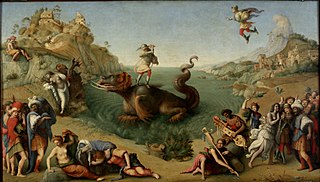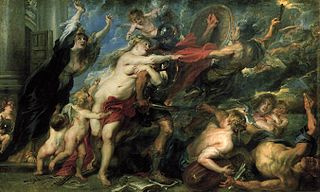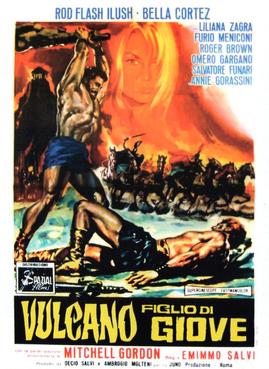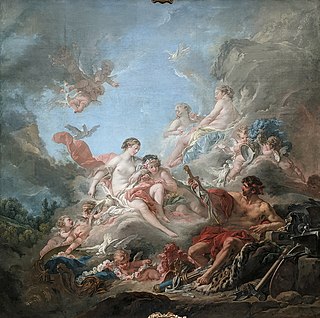
Venus is a Roman goddess, whose functions encompass love, beauty, desire, sex, fertility, prosperity, and victory. In Roman mythology, she was the ancestor of the Roman people through her son, Aeneas, who survived the fall of Troy and fled to Italy. Julius Caesar claimed her as his ancestor. Venus was central to many religious festivals, and was revered in Roman religion under numerous cult titles.

Piero di Cosimo, also known as Piero di Lorenzo, was an Italian painter of the Renaissance.

Louis-Jean-François Lagrenée was a French rococo painter and student of Carle van Loo. He won the Grand Prix de Rome for painting in 1749 and was elected a member of the Académie royale de peinture et de sculpture in 1755. His younger brother Jean-Jacques Lagrenée was also a painter.
The Loves of Mars and Venus by John Weaver was arguably the first modern ballet, the first dance work to tell a story through dance, gesture and music alone. Its first performance was at London's Drury Lane Theatre on Saturday 2 March 1717.

Joachim Anthoniszoon Wtewael was a Dutch Mannerist painter and draughtsman, as well as a highly successful flax merchant, and town councillor of Utrecht. Wtewael was one of the leading Dutch exponents of Northern Mannerism, and his distinctive and attractive style remained largely untouched by the naturalistic developments happening around him, "characterized by masterfully drawn, highly polished figures often set in capricious poses". Wtewael was trained in the style of late 16th-century Haarlem Mannerism and remained essentially faithful to it, despite painting well into the early period of Dutch Golden Age painting.
Venus and Mars may refer to:

Sebastiano Mazzoni was an Italian painter of the Baroque period.

Alessandro Leone Varotari (4 April 1588 – 20 July 1649), also commonly known as Il Padovanino, was an Italian painter of the late-Mannerist and early-Baroque Venetian school, best known for having mentored Pietro Liberi, Giulio Carpioni, and Bartolommeo Scaligero. He was the son of Dario Varotari the Elder and the brother of painter Chiara Varotari, who accompanied him on his travels and assisted with his work.

Mars Being Disarmed by Venus is the last painting produced by the French artist Jacques-Louis David. He began it in 1822 during his exile in Brussels and completed it three years later, before dying in an accident in 1825. The work combines idealization with elements of realism. Specifically, David integrated the idealized forms of mythological painting with a realist attention to detail. This combination of two seemingly incompatible principles also plays an important role in the themes of the painting, most notably in its treatment of masculinity and femininity.

Apollo in the Forge of Vulcan, sometimes referred to as Vulcan's Forge, is an oil painting by Diego de Velázquez completed after his first visit to Italy in 1629. Critics agree that the work should be dated to 1630, the same year as his companion painting Joseph's Tunic. It appears that neither of the two paintings were commissioned by the king, although both became part of the royal collections within a short time. The painting became part of the collection of the Museo del Prado, in Madrid, in 1819.

In classical mythology, Cupid is the god of desire, erotic love, attraction and affection. He is often portrayed as the son of the love goddess Venus and the god of war Mars. He is also known as Amor. His Greek counterpart is Eros. Although Eros is generally portrayed as a slender winged youth in Classical Greek art, during the Hellenistic period, he was increasingly portrayed as a chubby boy. During this time, his iconography acquired the bow and arrow that represent his source of power: a person, or even a deity, who is shot by Cupid's arrow is filled with uncontrollable desire. In myths, Cupid is a minor character who serves mostly to set the plot in motion. He is a main character only in the tale of Cupid and Psyche, when wounded by his own weapons, he experiences the ordeal of love. Although other extended stories are not told about him, his tradition is rich in poetic themes and visual scenarios, such as "Love conquers all" and the retaliatory punishment or torture of Cupid.

Venus and Mars is a panel painting of about 1485 by the Italian Renaissance painter Sandro Botticelli. It shows the Roman gods Venus, goddess of love, and Mars, god of war, in an allegory of beauty and valour. The youthful and voluptuous couple recline in a forest setting, surrounded by playful baby satyrs.

Consequences of War, also known as Horror of war, was executed between 1638-1639 by Peter Paul Rubens in oil paint on canvas. It was painted for Ferdinando II de' Medici. Although commissioned by an Italian, art historians characterize both the work and the artist as Flemish Baroque. It serves as a commentary on a European continent ravaged by the Thirty Years' War, and the artist employed numerous symbols, both contemporary and ancient, to deplore the state of the continent.

Vulcan, Son of Giove is a 1962 Italian fantasy-adventure film directed and co-written by Emimmo Salvi in his directorial debut. At the time of his death in 1989 he was preparing a film on Zeus. The film is also known as Vulcan, Son of Jupiter. The film was partly shot in Iran.

The Parnassus is a painting by the Italian Renaissance painter Andrea Mantegna, executed in 1497. It is housed in the Musée du Louvre of Paris.
The Complaint of Mars, is one of Geoffrey Chaucer's short poems that has elicited a variety of critical commentary. While this poem has been seen as allegorical, astronomical, and interpretive-appreciative in nature, a number of critics have examined the poem only as a description of an astronomical event. While this event is evident in the story, the discrepancies between the story and the actual condition in the skies has provided a useful examination of astrological beliefs in Chaucer's time.

Venus and Mars is an oil painting on canvas painted in the 1570s by the Italian Renaissance artist Paolo Veronese.
Chiara Fancelli was a figure in Florentine history, best known as the daughter of the architect Luca Fancelli and the wife and model of Pietro Perugino.

Vulcan Presenting Venus with Arms for Aeneas is an oil-on-canvas painting by François Boucher, executed in 1757 and now in the Louvre in Paris. He produced it as the basis for one of a set of tapestries on The Loves of the Gods. It depicts the homely but muscular Vulcan on the ground in the right, offering up to the more celestial Venus the weapons he has forged for her son Aeneas.

Leda and the Swan is a c.1550-1560 oil on canvas painting by Jacopo Tintoretto. Doubts on its autograph status were quelled by its restorations in 1988 and 1994. Art historians do not agree on its dating, though most now place it in the 1550s, the same period as his Mars and Venus Surprised by Vulcan and Joseph and Potiphar's Wife. Judith and Holofernes (Prado) was also previously dated to that decade but has now been downgraded to a studio work.
















